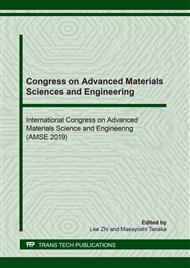p.79
p.84
p.90
p.99
p.105
p.110
p.116
p.125
p.132
Separation of Particles Composed of a Solid Solution [Mg2SiO4 -Fe2SiO4] in the Sequence of Fe2+ Concentration Using a Pocketsize Magnetic-Circuit
Abstract:
Magentic separation generally required strong magnetic forces induced in ferromagnetic or strong paramagnetic particles; in order to realize the separation in diamagnetic or weak paramagnetic particles, it was necessary to attach magnetic beads or magnetic ions to induce the strong magnetic force. A method to separate mixture of weak magnetic particles by its concentration of paramagnetic ferrous ion is newly proposed, which does not require the abovementioned magnetic attachments. The efficiently of the new method is experimentally examined using a pocketsize magnetic circuit (4.5 cm x2.0 cm x 1.0 cm) and a piece of cross sectional paper (5.0 cm x1.0cm). The separation is based on a principle that velocity of a translating particle, induced by a magnetic volume force in an area of monotonically decreasing field, is uniquely determined only by its magnetic susceptibility (per unit mass) of the particle; the velocity is independent to mass of particle. By examining the spectra of the separated particles recovered on the cross sectional paper, a histogram on Fe concentration is easily obtained for the particles without the need of consuming them.
Info:
Periodical:
Pages:
105-109
Citation:
Online since:
May 2020
Authors:
Price:
Сopyright:
© 2020 Trans Tech Publications Ltd. All Rights Reserved
Share:
Citation:


